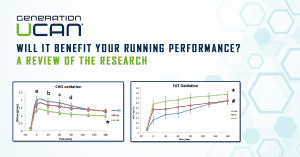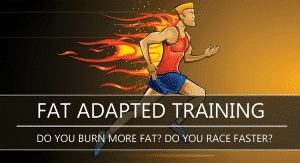It’s hard to overstate the importance of fueling in the marathon.
Without proper carbohydrate intake, you’re going to have a very difficult time making it to the finish without “hitting the wall” and slowing down drastically. We’ve covered in two previous articles how to calculate when you’ll run out of glycogen and how to calculate your fueling needs. But until now, we haven’t discussed the ins and outs of the various options for fueling up.
Luckily, the ideal fuel source for marathoning only needs one thing: sugar.
However, thanks to the huge range of products available at most specialty running stores, finding the right source, concentration and consistency can be confusing and intimidating. Really, though, your choices can be sorted into three categories: liquid sports drinks, gels, and solids.
Each have aspects which make them appropriate for different occasions and different runners. In this article, we’ll break down the pros and cons of each and how to find the ideal type for you.
Sports drinks
Sports drinks are by far the most ubiquitous refueling option. There are well-known options, like Gatorade and Powerade, plus a number of lesser-known competitors. You can find sports drinks pre-mixed at grocery stores, but you might have to head elsewhere or shop online to find mixable powder.
Aim for electrolytes instead of the extras
Historically, sports drinks were made within a fairly narrow range of specifications, but now that sports drinks have become a mainstream beverage, that’s not always the case. This can lead to a lot of “extra” ingredients, which usually don’t help
- Watch out for low-calorie versions or energy drinks in disguise. As mentioned above, all you’re really interested in is the sugar content. Since low calorie means no sugar, the sports drink is basically doing little to help replenish glycogen.
- Some electrolytes (like sodium and potassium) are desirable for rehydration, but “extras” like vitamins, protein, and herbal supplements won’t do you any good. We recommend EnduroPacks Electrolyte spray, which you can spray in any drink, and it has zero calories or sugar.
- When a sports drink contains a mix of both glucose and fructose, they can be absorbed faster than either sugar alone, but you’ll find a range of carbohydrate sources in different sports drinks. Avoid these and focus on glucose and fructose
- Oddly, the only mixtures you want to avoid are “natural” options like pure fruit juice. These have too much fructose and can cause stomach problems while running.
Sports drink mixes
Research has shown that the most efficient and effective sports drinks have a carbohydrate concentration of 6 to 8 percent. This concentrations allows the fluid to absorb into the bloodstream quickly, at about the rate of plain water.
On the other hand, a more concentrated solution will result in slower emptying of the stomach and can cause gastrointestinal problems.
These numbers were derived from scientific experiments on the absorption of sugar from the stomach and the tolerability of different concentrations of carbohydrates.
Solutions that are more watered-down aren’t necessarily worse, but they do require more fluid intake for the same amount of calories.
Most pre-mixed sports drinks are within this range (Gatorade, for example, is 5.8% sugar), but if you’re mixing your own from powder, you’ll have to pay attention to the instructions and perhaps do some math yourself.
Even at standard-mixed concentrations, you might find sports drinks to be too sweet for you to tolerate. In this case, you should experiment with watered-down mixes so you can adequately refuel during running. Over time, you may be able to work your way up to full-concentration mixes, but you might always need to water down your sports drinks.
Settling for the standard concentration
Often, the choice of sports drink and the ratio at which it’s mixed is not your decision to make. Unless you’re an elite runner, on race day you’re probably stuck with whatever the race organizers have decided on. It’s usually safe to assume that the sports drink being provided is mixed to the standard concentration.
This is why one of the most essential marathon nutrition strategies is to practice using the exact same fluids you’ll be taking on the course.
Watering down race-provided sports drinks is pretty easy: just grab a cup of water after you’ve downed your sports drink. When it comes to measuring volumes, a standard paper cup holds about five fluid ounces, which also makes estimating your fluid intake easy.
Gel and solid carb sources
Though sports drinks are versatile and easily available, they aren’t always sufficient for refueling during a marathon.
As Tim Noakes remarks in Lore of Running, it can be quite difficult to actually ingest large amounts of a sports drink without suffering from bloating and fullness. Gel and solid carbohydrate sources offer a workaround.
Gel and solid carb sources are usually sold in single-use packets which contain about 100 calories each. Gels are thick syrups that are intended to be washed down with a small amount of water, and “solids” are sugary chewable foods that are much like fruit snacks for kids.
Gels and solids vs sports drinks
- Gels and solids are much more energy-dense than sports drinks, and this in turn makes it a lot more manageable to hit high levels of carbohydrate intake during a marathon or other long-distance event.
- Always take energy gels with water, never alone and never with Gatorade. Without water, energy gels will take longer to digest and enter the blood stream. If you take an energy gel with a sports drink, you run the risk of ingesting too much simple sugar at once. Taken together, a gel and sports drink could be delivering close to 60 grams of pure sugar – yack.
- Gels are also very easy to bring with you while you run, either in training or in a race. That way, you aren’t limited to fueling only at designated aid stations.
- The only drawbacks to these fuel sources are that they can be hard to stomach while running and they tend to be expensive. It’s important than that you experiment with trial and error to determine which gel is best for you. Some brands are more viscous, some taste better, and each flavor can be delicious to you but wretched to another runner. The important thing is that you have to experiment and find something that works.
Gels and GI issues
One study by Beate Pfeiffer and other researchers found that between 10 and 20 percent of runners will have serious gastrointestinal problems like nausea, cramps, bloating, and diarrhea when using carbohydrate gels. Pfeiffer et al. recommend that runners experiment with different fueling strategies in training so that there are no surprises on race day.
Unfortunately, gels and solids on the market today seem to be even more jam-packed with unhelpful additives like amino acids, protein, vitamins, and other supplements. These certainly drive up the cost (and profits for manufactures), but don’t do you any good, at least as far as marathon fueling is concerned.
For a cheap replacement, you can try plain honey—it’s got just about the right ratio of glucose and fructose for maximum carb absorption, and there aren’t any additives!
A 2011 review study by researchers in the UK, Australia, and China emphasizes that no carbohydrate source—gel, solid, or liquid—has a distinct physiological performance advantage over any other. Your choice of fuel for your next marathon is largely a matter of personal preference.
Final message
Sports drinks, gels, and solids all have their own distinct advantages and disadvantages for a particular runner. Your stomach might not be able to handle highly-concentrated gels, or you might feel too bloated when trying to drink large volumes of sports drinks.
Calibrating the right mix of gels, solids, sports drinks, and plain water will take some trial and error, but in doing so, you can craft a marathon refueling plan to carry you through the finish line.





7 Responses
In any discussion involving energy sources, I think you need to include Tailwind Nutrition. Tailwind is a smaller company and “new kid on the block”, but has proven success from MANY endurance athletes doing really long races. http://www.tailwindnutrition.com/why-tailwind/
Useful info, thanks.
I’ve been experimenting with baby food pouches instead of gels for long races and training runs as they are easier on the stomach and not too sickly.
What do you think of substituting dates, other dried fruit or fruit leather as an alternative to processed gels and gummies? It’s the only solid fuel I’ve ever carried with me on my long runs. The gels all seem like candy and junk food to me. Also, I’ve experimented with making my own sports drinks. Thoughts on this? I’ve tried different sugar sources including maple syrup, honey and agave. Maybe it’s in my head, but with all but agave, I feel like I’m chasing the energy. Agave appears to give me a slower burn. Originally agave nectar was touted for being low glycemic. Now it appears to have fallen out of favor and is being considered worse than corn syrup and more refined. It seems to work OK for me though, but I may start giving honey a shot again. In addition to a sugar source, I add plain coconut water, matcha green tea powder (which aside from a bit of caffeine, really works to give the whole thing a smooth consistency), the contents of a few buffered electrolyte caps, a pinch of sea salt and usually the juice of a lemon, lime or orange. I top the whole mess off with fresh water.
well i ran my first half marathon last year and did ok..all i did was stop off at each and every water station took a gulp or two and run my race..so for this year 2015 am traning for my first full marathon and its run rest cross train and run some more plus lots of water during my training runs (thank goodness for 7 elevens on everycorner..besides the little break and a smile or too helps with the training..so bottom line is i plan to sticking with water myself been looking at all the gels and its not worth it..but if thats your thing go for it i just want to keep it simple and run to the finish…wish you and myself happy running…mitch
Hi Mitch, thanks for sharing, the good thing is that you learned to listen to your body. If it works for you, then keep it going, just make sure if you increase your distance, you do then reconsider gels as it would be very difficult to run a marathon without any kind of fuel. Best of luck!
I can run a half marathon on just water but no way would be able to complete a marathon particularly at twenty miles without serious distress they do make a big difference for me – I find Torq to be the best although others I know take a banana (not easy to carry I know) or jelly babies
Hi Tim, thanks for sharing your experiences. It is great you have found something that works for you! Keep using it!